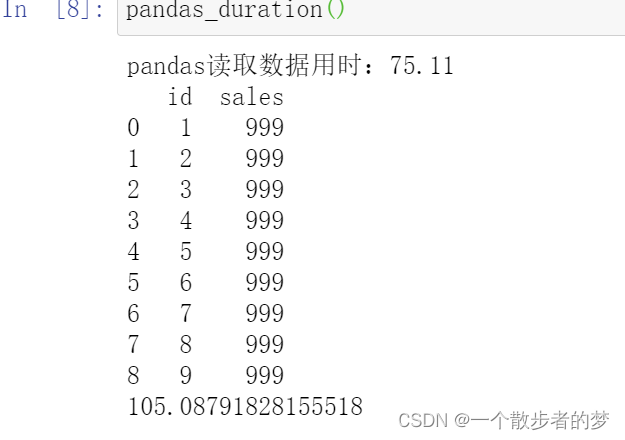标题
- 1. 内存模型图
- 2. 分析流程
- 3.追溯本源————源码分析
- 3.1 AVPacket队列 什么时候生成的?
- 4 .AVPacket和AVFrame相关操作API
- 5. av_read_frame源码分析
1. 内存模型图

2. 分析流程
我们解复用后,媒体流数据就会被分离开来,分别生成对应AVPacketList,然后通过av_read_frame读取一个AVPacket来读取,然而如果有一个新的AVPacket也想要指向之前的AVPacket,那么内存模型应该是什么样子的呢?
通过思考应该有2种模型:
1.两个AVPacket同时指向同一块数据区域
2.先拷贝之前的数据区域,然后再给给新的AVPacket使用

由于我们数据区域是只读的,因此我们可以采用第一种方案比较稳妥,但是又迎来的新的问题,如果我们avpacket释放了数据,那么数据就会消失,那么avpacket2就会失效,那么该如何解决呢?
如果有朋友了解过C++的智能指针设计的话,那么就知道这种情况改如何设计了.
我们通过引入一个变量来标记该数据被多少AVPacket所使用,当该变量为1时释放就会真正的释放掉改数据.
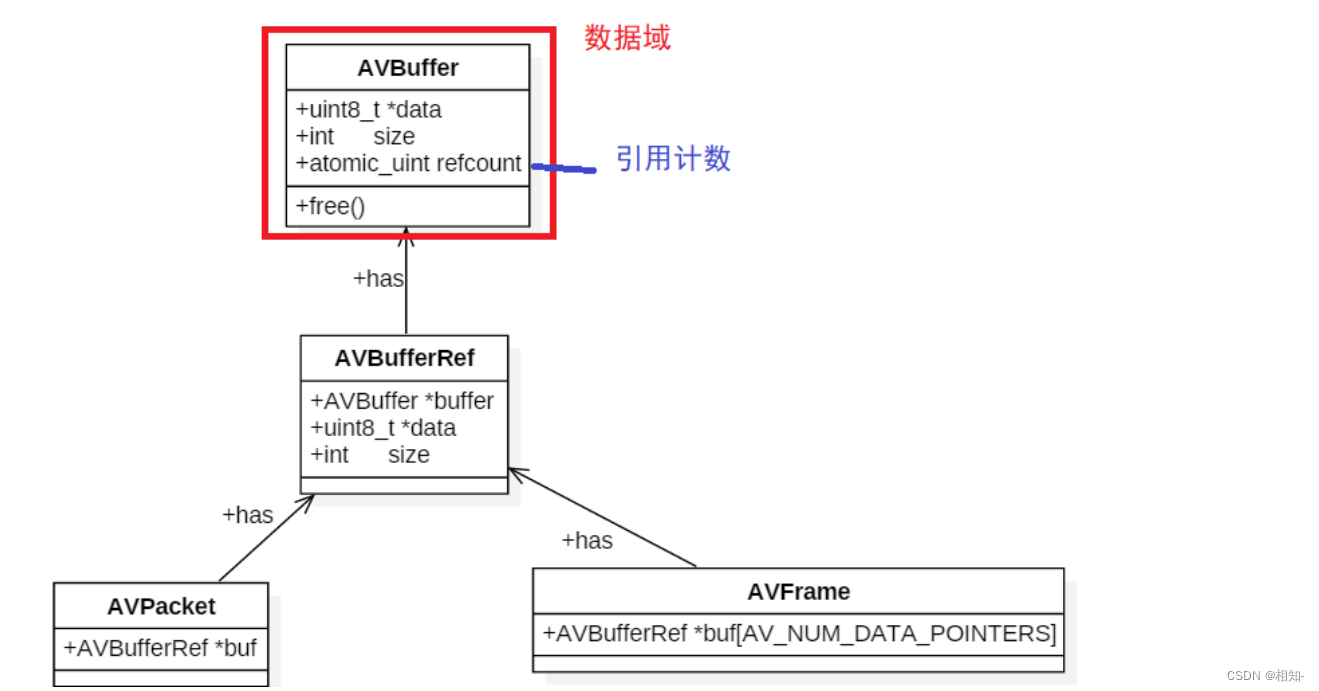
3.追溯本源————源码分析
3.1 AVPacket队列 什么时候生成的?
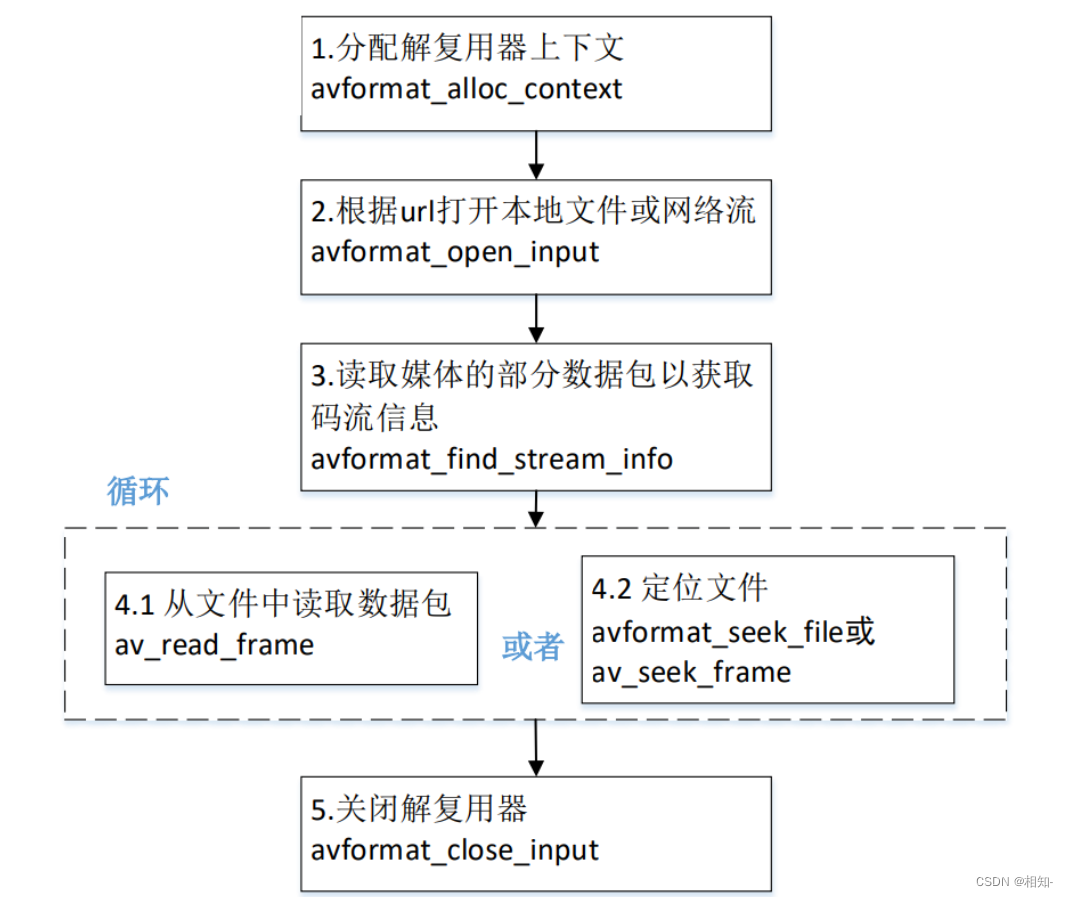
我们先看一下上面这个流程.
我们仔细阅读一下avformat_open_input这个函数.
int avformat_open_input(AVFormatContext **ps, const char *filename,ff_const59 AVInputFormat *fmt, AVDictionary **options)
{AVFormatContext *s = *ps;int i, ret = 0;AVDictionary *tmp = NULL;ID3v2ExtraMeta *id3v2_extra_meta = NULL;if (!s && !(s = avformat_alloc_context()))return AVERROR(ENOMEM);if (!s->av_class) {av_log(NULL, AV_LOG_ERROR, "Input context has not been properly allocated by avformat_alloc_context() and is not NULL either\n");return AVERROR(EINVAL);}if (fmt)s->iformat = fmt;if (options)av_dict_copy(&tmp, *options, 0);if (s->pb) // must be before any goto fails->flags |= AVFMT_FLAG_CUSTOM_IO;if ((ret = av_opt_set_dict(s, &tmp)) < 0)goto fail;if (!(s->url = av_strdup(filename ? filename : ""))) {ret = AVERROR(ENOMEM);goto fail;}#if FF_API_FORMAT_FILENAME
FF_DISABLE_DEPRECATION_WARNINGSav_strlcpy(s->filename, filename ? filename : "", sizeof(s->filename));
FF_ENABLE_DEPRECATION_WARNINGS
#endifif ((ret = init_input(s, filename, &tmp)) < 0)goto fail;s->probe_score = ret;if (!s->protocol_whitelist && s->pb && s->pb->protocol_whitelist) {s->protocol_whitelist = av_strdup(s->pb->protocol_whitelist);if (!s->protocol_whitelist) {ret = AVERROR(ENOMEM);goto fail;}}if (!s->protocol_blacklist && s->pb && s->pb->protocol_blacklist) {s->protocol_blacklist = av_strdup(s->pb->protocol_blacklist);if (!s->protocol_blacklist) {ret = AVERROR(ENOMEM);goto fail;}}if (s->format_whitelist && av_match_list(s->iformat->name, s->format_whitelist, ',') <= 0) {av_log(s, AV_LOG_ERROR, "Format not on whitelist \'%s\'\n", s->format_whitelist);ret = AVERROR(EINVAL);goto fail;}avio_skip(s->pb, s->skip_initial_bytes);/* Check filename in case an image number is expected. */if (s->iformat->flags & AVFMT_NEEDNUMBER) {if (!av_filename_number_test(filename)) {ret = AVERROR(EINVAL);goto fail;}}s->duration = s->start_time = AV_NOPTS_VALUE;/* Allocate private data. */if (s->iformat->priv_data_size > 0) {if (!(s->priv_data = av_mallocz(s->iformat->priv_data_size))) {ret = AVERROR(ENOMEM);goto fail;}if (s->iformat->priv_class) {*(const AVClass **) s->priv_data = s->iformat->priv_class;av_opt_set_defaults(s->priv_data);if ((ret = av_opt_set_dict(s->priv_data, &tmp)) < 0)goto fail;}}/* e.g. AVFMT_NOFILE formats will not have a AVIOContext */if (s->pb)ff_id3v2_read_dict(s->pb, &s->internal->id3v2_meta, ID3v2_DEFAULT_MAGIC, &id3v2_extra_meta);if (!(s->flags&AVFMT_FLAG_PRIV_OPT) && s->iformat->read_header)if ((ret = s->iformat->read_header(s)) < 0)goto fail;if (!s->metadata) {s->metadata = s->internal->id3v2_meta;s->internal->id3v2_meta = NULL;} else if (s->internal->id3v2_meta) {int level = AV_LOG_WARNING;if (s->error_recognition & AV_EF_COMPLIANT)level = AV_LOG_ERROR;av_log(s, level, "Discarding ID3 tags because more suitable tags were found.\n");av_dict_free(&s->internal->id3v2_meta);if (s->error_recognition & AV_EF_EXPLODE) {ret = AVERROR_INVALIDDATA;goto close;}}if (id3v2_extra_meta) {if (!strcmp(s->iformat->name, "mp3") || !strcmp(s->iformat->name, "aac") ||!strcmp(s->iformat->name, "tta") || !strcmp(s->iformat->name, "wav")) {if ((ret = ff_id3v2_parse_apic(s, &id3v2_extra_meta)) < 0)goto close;if ((ret = ff_id3v2_parse_chapters(s, &id3v2_extra_meta)) < 0)goto close;if ((ret = ff_id3v2_parse_priv(s, &id3v2_extra_meta)) < 0)goto close;} elseav_log(s, AV_LOG_DEBUG, "demuxer does not support additional id3 data, skipping\n");}ff_id3v2_free_extra_meta(&id3v2_extra_meta);if ((ret = avformat_queue_attached_pictures(s)) < 0)goto close;if (!(s->flags&AVFMT_FLAG_PRIV_OPT) && s->pb && !s->internal->data_offset)s->internal->data_offset = avio_tell(s->pb);s->internal->raw_packet_buffer_remaining_size = RAW_PACKET_BUFFER_SIZE;update_stream_avctx(s);for (i = 0; i < s->nb_streams; i++)s->streams[i]->internal->orig_codec_id = s->streams[i]->codecpar->codec_id;if (options) {av_dict_free(options);*options = tmp;}*ps = s;return 0;close:if (s->iformat->read_close)s->iformat->read_close(s);
fail:ff_id3v2_free_extra_meta(&id3v2_extra_meta);av_dict_free(&tmp);if (s->pb && !(s->flags & AVFMT_FLAG_CUSTOM_IO))avio_closep(&s->pb);avformat_free_context(s);*ps = NULL;return ret;
}
其中关键的是:
if ((ret = avformat_queue_attached_pictures(s)) < 0)goto close;avformat_open_input调用了avformat_queue_attached_pictures这个函数,那么我看一下这个函数是干嘛的?
int avformat_queue_attached_pictures(AVFormatContext *s)
{int i, ret;for (i = 0; i < s->nb_streams; i++)if (s->streams[i]->disposition & AV_DISPOSITION_ATTACHED_PIC &&s->streams[i]->discard < AVDISCARD_ALL) {if (s->streams[i]->attached_pic.size <= 0) {av_log(s, AV_LOG_WARNING,"Attached picture on stream %d has invalid size, ""ignoring\n", i);continue;}ret = ff_packet_list_put(&s->internal->raw_packet_buffer,&s->internal->raw_packet_buffer_end,&s->streams[i]->attached_pic,FF_PACKETLIST_FLAG_REF_PACKET);if (ret < 0)return ret;}return 0;
}
根据函数很明显可以看出这个函数是对每一个流进行调用ff_packet_list_put构建AVPacketList链表.
我们仔细看一下ff_packet_list_put这个函数:
int ff_packet_list_put(AVPacketList **packet_buffer,AVPacketList **plast_pktl,AVPacket *pkt, int flags)
{AVPacketList *pktl = av_mallocz(sizeof(AVPacketList));int ret;if (!pktl)return AVERROR(ENOMEM);if (flags & FF_PACKETLIST_FLAG_REF_PACKET) {if ((ret = av_packet_ref(&pktl->pkt, pkt)) < 0) {av_free(pktl);return ret;}} else {// TODO: Adapt callers in this file so the line below can use// av_packet_move_ref() to effectively move the reference// to the list.pktl->pkt = *pkt;}if (*packet_buffer)(*plast_pktl)->next = pktl;else*packet_buffer = pktl;/* Add the packet in the buffered packet list. */*plast_pktl = pktl;return 0;
}
这个函数其实就是一个链表的尾插函数,每次都创建一个AVPacketList,而AVPacketList结构体中封装的是:AVPacket
typedef struct AVPacketList {AVPacket pkt;struct AVPacketList *next;
} AVPacketList;
那么到这里我们就回答了一开始标题的问题了.
4 .AVPacket和AVFrame相关操作API
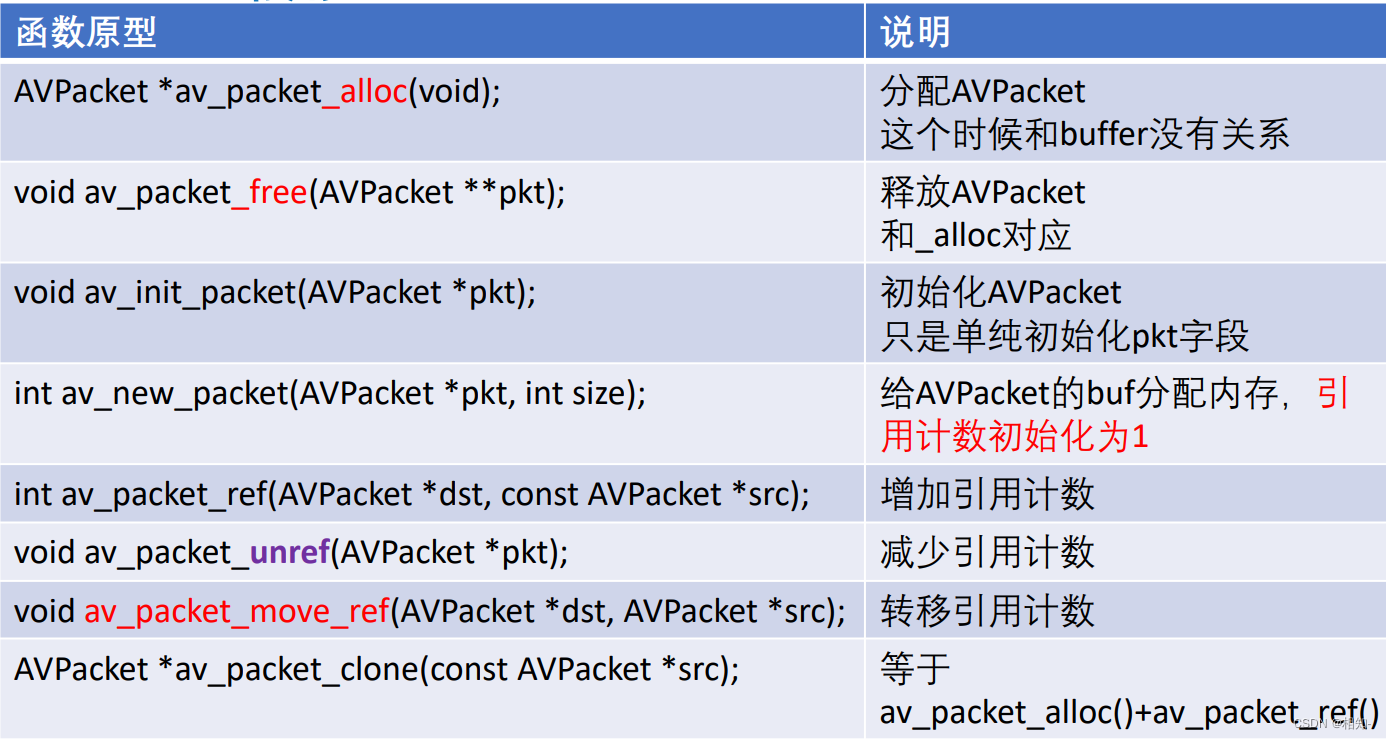
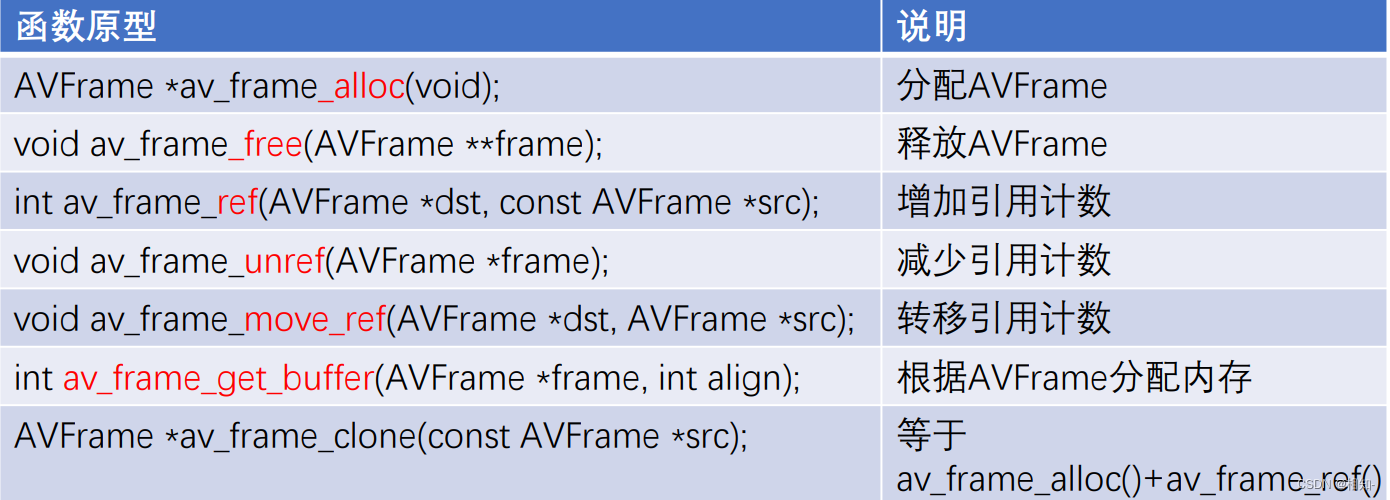
5. av_read_frame源码分析
int av_read_frame(AVFormatContext *s, AVPacket *pkt)
{const int genpts = s->flags & AVFMT_FLAG_GENPTS;int eof = 0;int ret;AVStream *st;if (!genpts) {ret = s->internal->packet_buffer? ff_packet_list_get(&s->internal->packet_buffer,&s->internal->packet_buffer_end, pkt): read_frame_internal(s, pkt);if (ret < 0)return ret;goto return_packet;}for (;;) {AVPacketList *pktl = s->internal->packet_buffer;if (pktl) {AVPacket *next_pkt = &pktl->pkt;if (next_pkt->dts != AV_NOPTS_VALUE) {int wrap_bits = s->streams[next_pkt->stream_index]->pts_wrap_bits;// last dts seen for this stream. if any of packets following// current one had no dts, we will set this to AV_NOPTS_VALUE.int64_t last_dts = next_pkt->dts;av_assert2(wrap_bits <= 64);while (pktl && next_pkt->pts == AV_NOPTS_VALUE) {if (pktl->pkt.stream_index == next_pkt->stream_index &&av_compare_mod(next_pkt->dts, pktl->pkt.dts, 2ULL << (wrap_bits - 1)) < 0) {if (av_compare_mod(pktl->pkt.pts, pktl->pkt.dts, 2ULL << (wrap_bits - 1))) {// not B-framenext_pkt->pts = pktl->pkt.dts;}if (last_dts != AV_NOPTS_VALUE) {// Once last dts was set to AV_NOPTS_VALUE, we don't change it.last_dts = pktl->pkt.dts;}}pktl = pktl->next;}if (eof && next_pkt->pts == AV_NOPTS_VALUE && last_dts != AV_NOPTS_VALUE) {// Fixing the last reference frame had none pts issue (For MXF etc).// We only do this when// 1. eof.// 2. we are not able to resolve a pts value for current packet.// 3. the packets for this stream at the end of the files had valid dts.next_pkt->pts = last_dts + next_pkt->duration;}pktl = s->internal->packet_buffer;}/* read packet from packet buffer, if there is data */st = s->streams[next_pkt->stream_index];if (!(next_pkt->pts == AV_NOPTS_VALUE && st->discard < AVDISCARD_ALL &&next_pkt->dts != AV_NOPTS_VALUE && !eof)) {ret = ff_packet_list_get(&s->internal->packet_buffer,&s->internal->packet_buffer_end, pkt);goto return_packet;}}ret = read_frame_internal(s, pkt);if (ret < 0) {if (pktl && ret != AVERROR(EAGAIN)) {eof = 1;continue;} elsereturn ret;}ret = ff_packet_list_put(&s->internal->packet_buffer,&s->internal->packet_buffer_end,pkt, FF_PACKETLIST_FLAG_REF_PACKET);av_packet_unref(pkt);if (ret < 0)return ret;}return_packet:st = s->streams[pkt->stream_index];if ((s->iformat->flags & AVFMT_GENERIC_INDEX) && pkt->flags & AV_PKT_FLAG_KEY) {ff_reduce_index(s, st->index);av_add_index_entry(st, pkt->pos, pkt->dts, 0, 0, AVINDEX_KEYFRAME);}if (is_relative(pkt->dts))pkt->dts -= RELATIVE_TS_BASE;if (is_relative(pkt->pts))pkt->pts -= RELATIVE_TS_BASE;return ret;
}
有了前面的知识铺垫,不难分析出read_frame_internal是调用ff_packet_list_put来获取AVPacket的,但是这里要注意ff_packet_list_put并不是简单的将AVPacket给read_frame_internal。
int ff_packet_list_get(AVPacketList **pkt_buffer,AVPacketList **pkt_buffer_end,AVPacket *pkt)
{AVPacketList *pktl;av_assert0(*pkt_buffer);pktl = *pkt_buffer;*pkt = pktl->pkt;*pkt_buffer = pktl->next;if (!pktl->next)*pkt_buffer_end = NULL;av_freep(&pktl);return 0;
}
根据源码可以得出,ff_packet_list_get先通过 *pkt = pktl->pkt; 将原来的数据直接拷贝给pkt,然后就释放掉了pkt1,也就是AVPacketList链表上的一个节点。那么这时候链表上就会消失一个AVPacket,这样做的好出就是,会将AVPacketList链表中的AVPacket慢慢释放掉,从而减少内存占用!
对于AVFrame相关API详解,我留到介绍编解码API流程时详细介绍,敬请期待~

